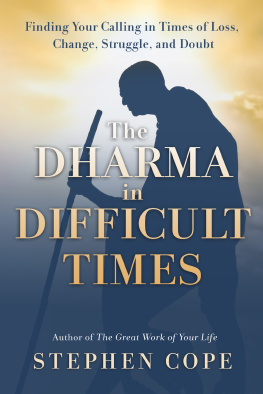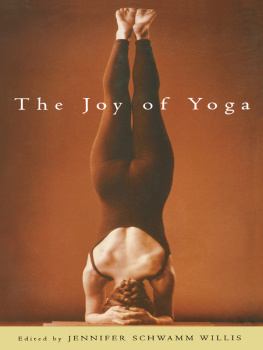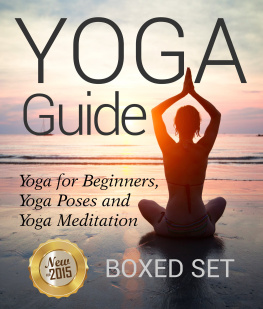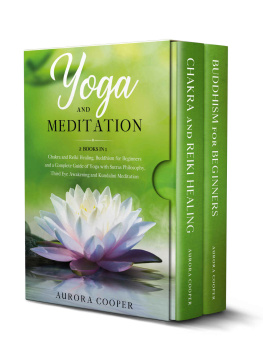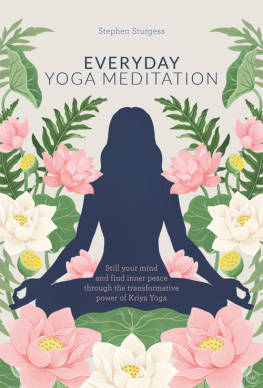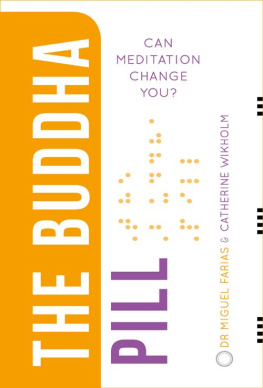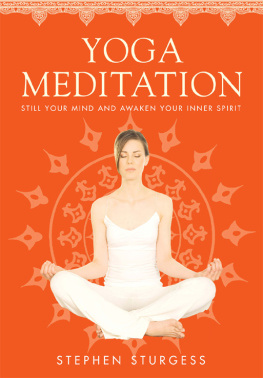will yoga &
meditation
really change my life?
will yoga &
meditation
really change my life?
PERSONAL STORIES FROM
25 OF NORTH AMERICAS LEADING TEACHERS
edited by Stephen Cope


The mission of Storey Publishing is to serve our customers
by publishing practical information that encourages personal independence
in harmony with the environment.
Edited by Deborah Balmuth, Bhavani Lorraine Nelson,
Atma Jo Ann Levitt, and Rachel Barenblat
Art direction by Cindy McFarland
Cover and text design by Susi Oberhelman
Cover photograph by Adam Mastoon
Text production by Jennifer Jepson Smith
Indexed by Danna Faulds
Photo credits are listed on
Copyright 2003 by Kripalu Center for Yoga & Health
Living from the Inside Out by Anne Cushman (pages 4151) originally appeared in Tricycle: The Buddhist Review.
Through the Eye of the Needle by Stephen Mitchell (page 7) originally appeared in Parables and Portraits (HarperCollins, 1991), used with permission from the author.
Portions of Practicing to Save My Life by Cyndi Lee are excerpted from her forthcoming book, Yoga Body, Buddha Mind (Riverhead Books, 2004), used with permission of the publisher.
To Waiting by W. S. Merwin (page 127) 2001 by W. S. Merwin, reprinted with the permission of the Wylie Agency, Inc.
All rights reserved. No part of this book may be reproduced without written permission from the publisher, except by a reviewer who may quote brief passages or reproduce illustrations in a review with appropriate credits; nor may any part of this book be reproduced, stored in a retrieval system, or transmitted in any form or by any means electronic, mechanical, photocopying, recording, or other without written permission from the publisher.
The information in this book is true and complete to the best of our knowledge. All recommendations are made without guarantee on the part of the author or Storey Publishing. The authors and publisher disclaim any liability in connection with the use of this information. For additional information, please contact Storey Publishing, 210 MASS MoCA Way, North Adams, MA 01247.
Storey books are available for special premium and promotional uses and for customized editions. For further information, please call 1-800-793-9396.
Printed in the United States by R.R. Donnelley
10 9 8 7 6 5 4 3 2 1
Library of Congress Cataloging-in-Publication Data
Will yoga & meditation really change my life? : personal stories from
Americas leading teachers / edited by Stephen Cope.
p. cm.
ISBN 1-58017-509-0 (alk. paper)
1. MeditationBuddhism. 2. Spiritual biographyUnited States. 3.
Yoga. I. Title: Will yoga and meditation really change my life?.
II. Cope, Stephen.
BQ5612 .W56 2003
294.34432dc22
2003014932
This volume is the first in a new series of Kripalu Books a collaborative venture between Kripalu Center for Yoga & Health in Lenox, Massachusetts, and Storey Publishing in North Adams, Massachusetts. All royalties from this book will be donated to support the Diversity Scholarship Fund at Kripalu Center, helping to ensure that people from all walks of life can participate in contemplative practice.
Tales from the Path
How does contemplative practice yoga and meditation change us? Does it change our personalities, our biochemistry, our neurology, our deep mental structures? Or just, perhaps, our attitudes and beliefs? Does it change us at all, really, in any permanent sort of way?
These are questions that have been hovering in the background of my life, my work, and my imagination for at least the last fifteen years.
Throughout most of those years, Ive been the Scholar-in-Residence and a senior instructor in yoga and meditation at Kripalu Center for Yoga & Health one of the largest residential yoga centers in America. Perched high up in the Berkshire hills of Western Massachusetts, Kripalu has proved a remarkable vantage point from which to observe an astonishing explosion of interest in the Eastern contemplative traditions particularly yoga and Buddhism. Each year Kripalu hosts over twenty-five thousand guests and hundreds of teachers who come to learn and teach techniques that they hope will allow them to live more fully.
Do these techniques work? Certainly, millions of people believe that they do. Their introduction into mainstream America has changed many of our ideas about spiritual life and spiritual practice and is beginning to modify even our ideas about what is possible for human beings. Contemplative practice has now gained enough influence in our culture to draw the interest of serious scientists psychologists, neurologists, and social scientists. I believe that in coming years well have some fascinating hard answers to my questions.
One thing is already certain, though: When the history of our time is written, there will be important chapters about the transmission of the Eastern contemplative traditions onto Western shores. What will these histories conclude? Will yoga and meditation have changed our lives? Our culture? Do we have enough perspective yet to begin to make any meaningful responses to these questions? I think we do. In fact, I think that in this historical moment we have a very interesting perspective indeed.
Im part of a significant slice of the baby-boom generation of Americans who have now lived most of our adult lives deeply influenced by contemplative practice. As I look around at my peers, I realize that many of us are going gray, and contemplating our retirement packages. Well, what do we have to say for ourselves? How has thirty years of contemplative practice transformed us? How has it transformed our lives, families, beliefs, bodies, interest in social activism, sense of compassion, point of view about aging and death?
And on top of this, of course, comes another question: Is thirty years a real perspective? I believe that it is. It seems to me that this first generation of American contemplative practitioners holds a fascinating piece of American spiritual and religious history.
Most of my fellow practitioners remember as I do the heady days of the early 1970s, when yoga and meditation were exotic new birds. In those years, I was a graduate student in theology at Episcopal Divinity School in Cambridge, Massachusetts. It was a wild time to be studying theology: America was in the first flush of its romance with the contemplative traditions, and on any given Saturday evening you could meet your guru in Harvard Square. Chogyam Trungpa, Rinpoche, the great Tibetan teacher, had just decamped from England with his unique combination of crazy wisdom and elegant prose; Swami Muktananda, sporting his famous ostrich feather, was on his tour of America astonishing students with his apparently supernormal powers; Swami Satchidananda had opened the Woodstock Festival and was already developing a large following of young American yogis; Joseph Goldstein, Jack Kornfield, and Sharon Salzberg were beginning to teach Vipassana meditation in a variety of venues in rural New England; and Suzuki Roshi was developing a whole generation of inspired Zen practitioners at the San Francisco Zen Center.
Thirty years have passed since those remarkable and colorful days. Its now quite clear that the transmission of the Eastern contemplative traditions onto American soil was not just a passing fad. Yoga has become the fastest growing practice in America burgeoning from six million practitioners in 1994 to more than fifteen million today. Buddhism is one of the fastest growing religions on our continent. And the Western practice communities of these two traditions have become highly sophisticated anchored as they are by a whole host of study centers, institutes, retreat centers, and centers for daily practice. These traditions are here to stay, and are now part of mainstream America.
Next page


